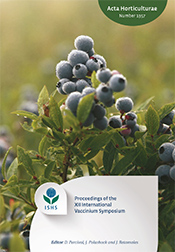Ver ítem
- xmlui.general.dspace_homeCentros Regionales y EEAsCentro Regional Tucumán - Santiago del EsteroEEA FamailláArtículos científicosxmlui.ArtifactBrowser.ItemViewer.trail
- Inicio
- Centros Regionales y EEAs
- Centro Regional Tucumán - Santiago del Estero
- EEA Famaillá
- Artículos científicos
- Ver ítem
Parasitoids associated with the invasive pest Drosophila suzukii (Diptera: Drosophilidae) in Argentina and their potential role as biological control agents of this pest in blueberry orchards
Resumen
Argentina's organic blueberry exports are approximately 2,200 t, which is mainly shipped to North America, Europe, and South-East Asia, mostly from September to November (spring). Organic fresh blueberries range third in volume of organic fruits exported, behind pears and apples. The spotted wing Drosophila (SWD) is an exotic pest that increasingly threatens Argentina's blueberry industry since its irruption in 2014. In northern Argentina, where most of
[ver mas...]
Argentina's organic blueberry exports are approximately 2,200 t, which is mainly shipped to North America, Europe, and South-East Asia, mostly from September to November (spring). Organic fresh blueberries range third in volume of organic fruits exported, behind pears and apples. The spotted wing Drosophila (SWD) is an exotic pest that increasingly threatens Argentina's blueberry industry since its irruption in 2014. In northern Argentina, where most of the blueberry acreage is established, the rainy season begins between the end of October and the first weeks of November, bringing on ideal conditions (mild temperatures and adequate soil and air moisture) for SWD reproduction and fruit infestation. For the control of SWD, insecticides are not effective and cultural control is complex. Besides, little is known about local beneficial organisms that could regulate SWD populations. Frugivorous drosophilids are mainly attacked by larvae and pupae parasitoids. The former are endoparasitoids that interact with the host's immune system and tend to have a narrow host range; on the contrary, pupae parasitoids are ecto- or endoparasitoids and tend to be generalists, attacking a wide range of hosts. SWD invasion encouraged studies aimed to explore the presence of local parasitoids that would contribute to an environmentally sound management of the pest. As a result of this study, several hymenopteran parasitoid species have been identified in blueberry and other berry crops: Pachycrepoideus vindemmiae (pupae parasitoid; Pteromalidae), Trichopria sp. (pupae parasitoid; Diapriidae), Dieucoila octoflagella, Ganaspis hookeri, Ganaspis sp., Hexacola sp., Leptopilina boulardi, and Leptopilina clavipes (larvae parasitoids; Figitidae). They were captured in traps installed in berry orchards infested with SWD, or among fallen fruit, and/or emerged from fruit infested with SWD. Dieucoila octoflagella is a new species, recently recorded in Argentina by our group, whose adult was recovered from SWD pupae. The collection and identification of specimens remain in progress.
[Cerrar]

Autor
Funes, Claudia Fernanda;
Gallardo, Fabiana Edith;
Reche, Vanina Anadina;
Escobar, Lorena Ines;
Ovruski Alderete, Sergio Marcelo;
Kirschbaum, Daniel Santiago;
Descripción
Trabajo presentado al XII International Vaccinium Symposium
Fuente
Acta Horticulturae 1357 : 385-392 (2023)
Fecha
2023
Editorial
International Society for Horticultural Science (ISHS)
ISSN
2406-6168
ISBN
978-94-62613-56-0
Documentos Relacionados
Formato
pdf
Tipo de documento
artículo
Proyectos
(ver más)
INTA/2019-PD-E4-I101-001/2019-PD-E4-I101-001/AR./Prospección, Prevención y Control de Lobesia botrana, Drosophila suzukii, HLB y Carpocapsa
Palabras Claves
Derechos de acceso
Restringido
 Excepto donde se diga explicitamente, este item se publica bajo la siguiente descripción: Creative Commons Attribution-NonCommercial-ShareAlike 2.5 Unported (CC BY-NC-SA 2.5)
Excepto donde se diga explicitamente, este item se publica bajo la siguiente descripción: Creative Commons Attribution-NonCommercial-ShareAlike 2.5 Unported (CC BY-NC-SA 2.5)


